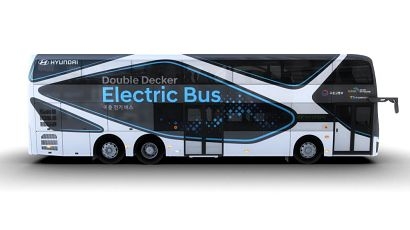
The all-new electric double-decker bus is being shown at the ‘Land, Infrastructure and Transport Technology Fair’ held in Korea, co-hosted by Hyundai and the national Ministry of Land, Infrastructure and Transport, lasting from May 29th to 31st.
To develop the company’s first electric double-decker bus, Hyundai worked for 18 months on a project supported by the Korean Ministry of Land, Infrastructure, and Transport, which began in 2017. The bus allows up to 70 passengers – 11 seats on the first floor and 59 seats on the second floor – 1.5 times as many passengers as compared to that of a regular bus. Through the implementation of two fixed-in-space wheelchairs, an automatic sliding ramp and low floor design, the double-decker bus secures added accessibility for disabled and mobility impaired passengers.
As part of the company’s effort to increase efficiency and to reduce vehicle emissions, Hyundai equipped the all-new bus with a 384 kWh water-cooled high-efficiency polymer battery, with a maximum 300 km driving range on a single charge. A full charge can be completed in 72 minutes.
The large electric double-decker bus is 12,990 mm long and 3,995 mm high. It runs on an independent suspension system in the first driving axle for a more comfortable ride, and a 240kW wheel motor axle combined with a motor in the second axle that minimises loss of electricity. A rear-wheel steering system works in coherence with the steering system of the first axle, optimizing steering performance.
"The double-decker electric bus is an environmentally friendly vehicle optimised for global eco-friendly trends” said ByoungWoo Hwang, Head of Commercial Vehicle Advanced Engineering team at Hyundai Motor. “This will not only ultimately improve the air quality, but also contribute greatly to easing commuting hour traffic congestion by accommodating more passengers.”
Various advanced safety features are also equipped on the bus to ensure the safety of the passengers:
Vehicle Dynamic Control (VDC) helps identify the driver's intended driving direction and maintain the vehicle in control.
Forward Collision-Avoidance Assist (FCA) uses the car’s front-facing camera to help detect an imminent collision and avoid impact or minimize damage by braking autonomously.
Lane Keeping Assist (LKA) helps prevent accidental lane departure by sensing road markings.
For additional information:

